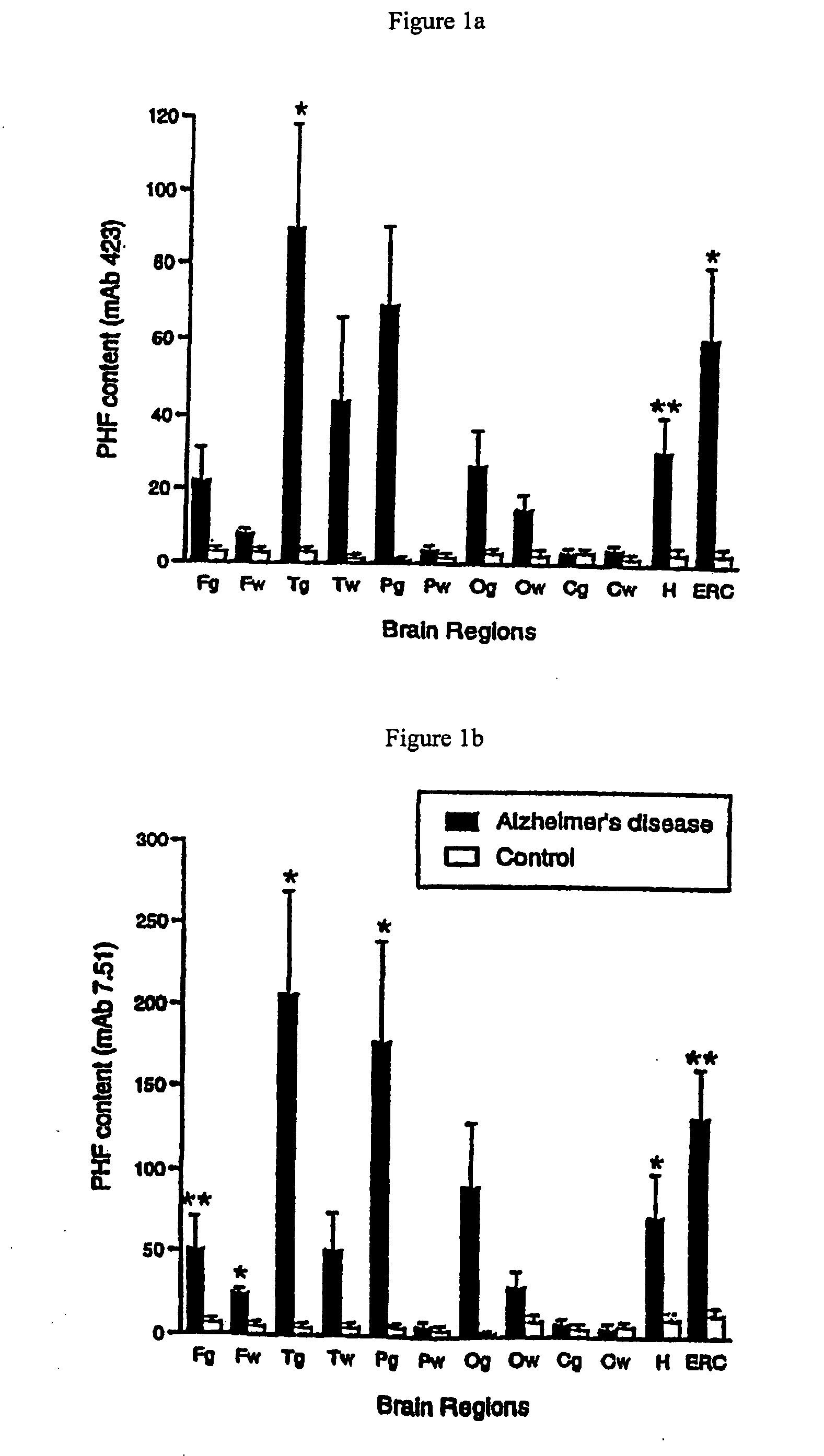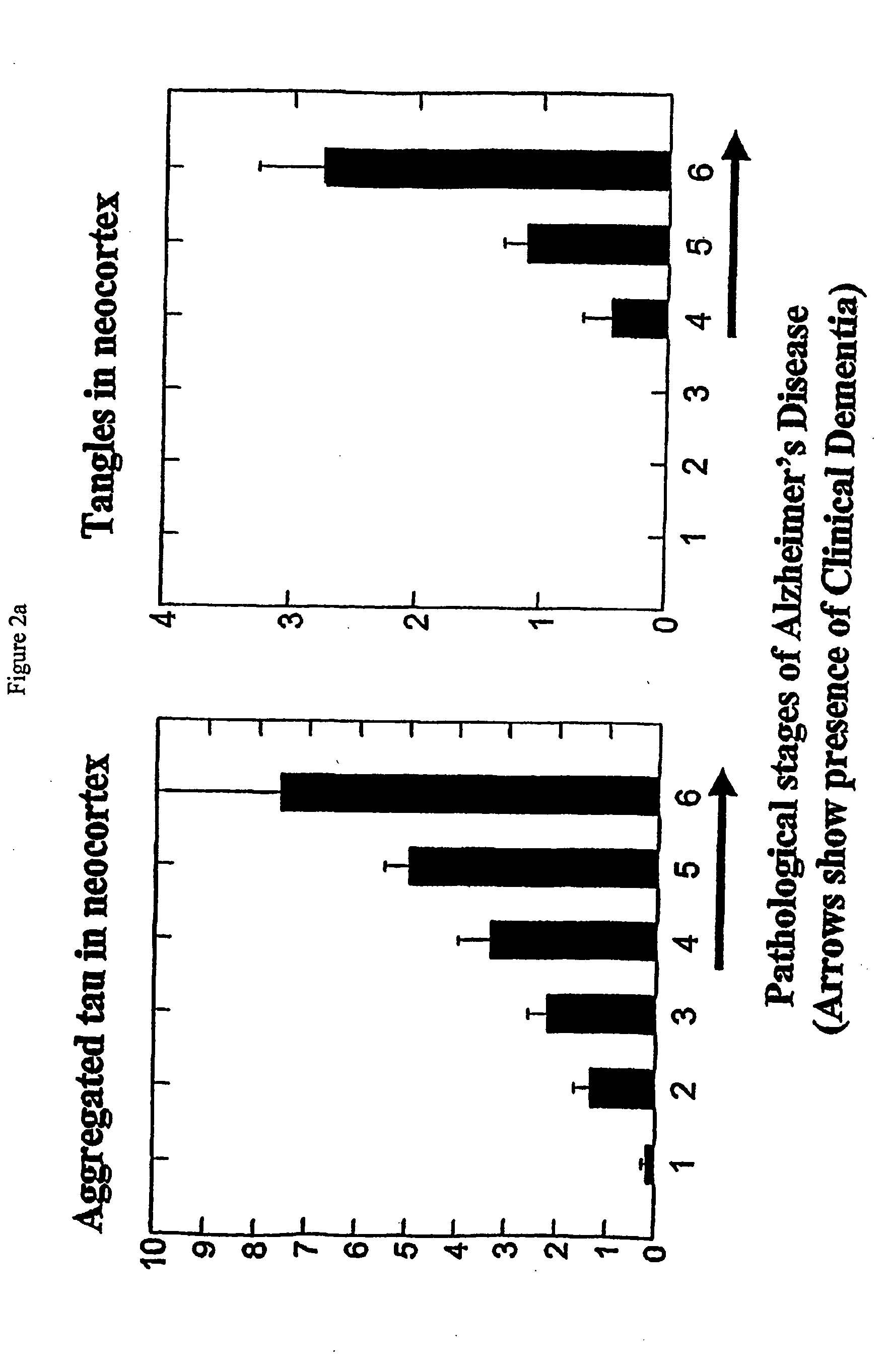Neurofibrillary labels
a neurofibrillary and label technology, applied in the field of neurofibrillary labeling and detection, can solve the problems of low detection accuracy, low degree of uncertainty, and low detection accuracy of neurofibrillary tangles,
- Summary
- Abstract
- Description
- Claims
- Application Information
AI Technical Summary
Benefits of technology
Problems solved by technology
Method used
Image
Examples
example 1
Aggregated Tau in Braak Staging
[0331]Based on immunochemical properties (Refs 26, 27, 30), it is possible to distinguish intracellular tangles from extracellular tangles. Both frequency of cases with tangles in these categories (ie probability) and their quantity (ie counts per mm2) were determined in a prospective case series and grouped into the regions known to represent stages in the progression of pathology according to the system of Braak and Braak
[0332]As shown in FIG. 25, stages 2-4 can be clearly distinguished from stage 1 on the basis of probability of extracellular tangles in E2 / Trans
and E4 / HC. Also shown are the figures for F / T / P regions (neocortical regions—frontal, temporal, parietal).
[0333]Conversely, intracellular tangles provide a poor basis for discrimination of early stages in these regions, but a good basis for discriminating stages 4 and 5 using neocortical regions. Similarly, when cases with MMSE scores greater than 21 in the 12 months prior to death were selec...
example 2
Assessment of Compounds Binding within the Aggregated Repeat Domain of PHF-Core Tau Protein
[0337]A prototype compound was obtained as one component of the crude, commercially-available preparation of thioflavin-S was separated into ˜20 distinct constituents by analytical thin-layer chromatography, and preparative chromatography. Tests showed that not all of the constituents were able to act as effective tangle ligands. Specifically, pure primulin (FIG. 5, compound 1a) was found to label tangles, but the benzothiazole thioflavin-T (FIG. 5, compound 1b) was much less effective, although it labelled amyloid preferentially.
[0338]Furthermore, compound 1a was found to displace compound 1b at tangles when the latter was introduced at 10-fold excess into crude tangle extracts.
[0339]A possible difference was postulated to be the sulphonate group at position 1 (FIG. 5, compound 2 [2-(4-amino phenyl)-6-methyl-1-sulphonate benzothiazole]). However, primulin (compound 1a) was found to displace t...
example 3
Determination of Optimum Dimensions of Ligand Molecules
[0344]FIG. 14 shows three of the structures described above, along with their dimensions as indicated. For example, the C11-C1 distance and C10-C1 distance are shown for primulin, a benzothiazole analogue (denoted ‘analog’), and ‘thiazin yellow’.
[0345]FIGS. 15 and 16 illustrate the crystal structures of the ‘B’ part of the primulin structure (Soon-Beng Teo et al., 1995, Acta Crystallogr., Sect. C, 591. As can be seen from FIG. 16, which is a ‘side-on’ view, the molecule is essentially flat, although it has a slight twist. The ‘A’ part of primulin can be computed from the same molecule. From this, one can derive measures of A+B, which provide an indication of the actual length of one of the active species of the present invention.
[0346]To compute the size of the “analog” shown in FIG. 14, measurement A was used from the data of FIG. 15, and measurement B was determined from a molecule denoted N2A and shown in FIGS. 17 and 18 (Gil...
PUM
 Login to View More
Login to View More Abstract
Description
Claims
Application Information
 Login to View More
Login to View More - R&D
- Intellectual Property
- Life Sciences
- Materials
- Tech Scout
- Unparalleled Data Quality
- Higher Quality Content
- 60% Fewer Hallucinations
Browse by: Latest US Patents, China's latest patents, Technical Efficacy Thesaurus, Application Domain, Technology Topic, Popular Technical Reports.
© 2025 PatSnap. All rights reserved.Legal|Privacy policy|Modern Slavery Act Transparency Statement|Sitemap|About US| Contact US: help@patsnap.com



